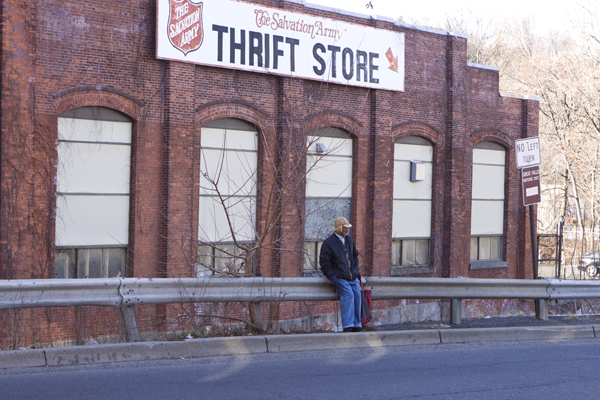
Paterson, NJ
[Update #2: 3/4/10 – DEP has revised the Paterson study and posted a new Final Report version dated 2/24 – More to follow on exactly how the changes to the Report happened – end update] –
[Update #1: 1/14/10 Bergen Record coverage: City’s Air May Raise Cancer Risk – end update]
In 2004, the NJ Department of Environmental Protection (DEP) embarked on a study of urban air quality in Paterson, NJ.
The City of Paterson was selected by DEP because it fits the classic textbook definition of an environmental injustice community.
The DEP study compared the dirty air of poor urban minority Paterson, with the clean air of wealthy white suburban Chester, NJ.
The $740,000 study was funded by a $500,000 grant from US EPA and supplemented by over $240,000 from DEP and other sources. The study was modeled on a previous “environmental justice” pilot project in Camden. The Paterson air study was originally planned to take 20 months, but it was delayed and not completed until late 2007 or early 2008.
But despite being competed 2 years ago, the DEP study still has not been published, publicly released, posted on the DEP website, or shared with community groups. What possibly could explain this delay???
We believe – but are unable to prove at this time because the DEP continues to withhold public documents requested over a month ago under OPRA – that DEP intentionally suppressed the study under former DEP Commissioner Lisa Jackson’s policy to require that DEP science undergo external “peer review” before public release.
Specifically, DEP managers issued a gag order on DEP scientists regarding release of data to the public.
After a series of controversial DEP scientific disclosures, DEP Commissioner Lisa Jackson sought to clamp down on public release of DEP science. DEP risk assessments of Jersey City , and risk fromCamden pollution illustrate exactly why Jackson was so concerned. To avoid these kind of embarrassing public controversies, in 2008, Jackson sought to block DEP publication of DEP research study of health risks in a professional scientific journal. An email from Jackson directed the Director of DEP’s Division of Science and Research to pull a DEP study from submission to a scientific journal: Jackson wrote
I believe this [chemical PFOA risk assessment] paper should be pulled from submission for publication pending the results of a peer review by a panel of scientists. I believe the same requirement should be applied to all scientific papers by members of this department that are based on work they do for this department or data that they have access to because of their work for this department.
I do not believe we will have this problem again since the new [Science Advisory Board] SAB will need to review any scientific paper that is related to DEP work or data before it is published. (see this for Jackson’s emails and her creation of a controversial science advisory board)
DEP scientists described the Paterson study as “right in line with Commissioner Campbell’s initiative on “Protecting Communities from Toxics”, based on previous work “Camden Waterfront South Air Toxics Pilot Project”
Paterson was selected because it had all the characteristics of a classic “environmental justice” community:

mother and child in industrial landscape of Paterson, NJ
- 19% of families live at or below the poverty level compared with 6.3% for the rest of the state
- 149,000 residents: 1/3 are white, 1/3 are black and 1/3 are some other race. 50% consider themselves Hispanic or Latino
- Paterson is in Passaic County which has the 5thhighest hospitalization rate for asthma in the state (NJDHSS, 2003)
- Paterson itself has 3x the state average for hospitalization rates dues to asthma (Wallace, 2003)
- a study found that 21% of participating 3rd graders had asthma or a related health problem (Freeman et al., 2002)
- 28 chemical air toxics (Leikauf, 2002) have been associated with making asthma worse
- EPA National Air Toxics Assessment (NATA) identified 14 air toxics causing elevated cancer and non-cancer risks in Passaic County
Here is what the study was designed to accomplish –
- community outreach, involvement, education
- provide a detailed emission inventory (1 mile radius around monitoring sites)
- model ambient levels of air toxics
- calculate cancer and other health risks
- Identify risk reduction strategies
Did the DEP study accomplish any of these objectives? We have no way of knowing because it was never published.

schools are impacted by local pollution sources
I recently was made aware of this project by scientists in DEP who suggested that I would be interested in the findings regarding the health risks around Paterson’s schools. There are dozens of Paterson schools that are negatively impacted by local air pollution sources. Thousands of kids are potential victims, and high asthma rates confirm this concern. I previously had questioned the validity of EPA preliminary air quality sampling results in NJ as part of a national program to monitor air quality from industrial sources located nearby 63 schools nationally, 2 of which are in NJ.(see “EPA Schools Air Toxics Data Misleading”)
Getting back to Paterson – based on the tip from the DEP scientist, I filed a public records request under OPRA for the Paterson data and final report that was transmitted from DEP to EPA.
I conducted a file review on December 28, 2009. I was unable to find many key documents, including the final research report submitted to EPA; or any evidence that the DEP EJ Program or the Environmental Justice Advisory Council were involved in the project (ironic, given that this was designed as an Environmental Justice project); or any internal DEP emails.
DEP still has not provided all the records requested and has refused to provide an unknown number of public documents under a claimed OPRA exemption. It is unclear how any scientific documents could possibly be considered exempt or deliberative under OPRA. Science is by definition an open and transparent process. Therefore, any attempts to interfere with public disclosure of data and DEP science are inherently suspect.
DEP found a “combined cancer risk of 846” in Paterson. It is 3 to 10 times higher than the Chester risk level.
I have no idea what a “combined cancer risk” is, but it appears to be the cumulative risk of multiple chemical pollutants. The worst risk is from dichlorobenzene which are 100-300 times safe levels. (see this for a toxicological profile of dichlorobenzene)
Here are some of the key findings EPA published:
These results indicated the significant impact of emissions from traffic, commercial activities and the operation of industrial facilities located in Paterson.
Benzene is emitted from numerous industrial operations as well as mobile sources and heating which may explain the seasonal variation.
Since dichlromethane is widely used as an industrial solvent/degreaser, paint stripper, aerosols, and pesticides, these relationships reflect the industrial nature and the anthropogenic activities which occur in urban centers such as Paterson.
Since tetrachlorethylene is a solvent used for degreasing and in the dry cleaning industry, these results reflect the industrial nature and the anthropogenic activities which occur in urban centers such as Paterson.
Trichloroethylene was not detected more than 50% of the time so no locational or temporal analysis was done. The maximum measured concentration was at the C site and exceeded the benchmark concentration for cancer but was 3 orders of magnitude beneath the reference concentration.
However, the weekday weekend differences for these pollutants were not observed in Chester. These observations again revealed the contribution of anthropogenic sources to ambient air pollution of these species in an urban environment.
I have many questions, based on what I found during my file review at DEP. Here are just a few initial concerns, which we will discuss in further detail in subsequent posts:
1. EPA posted an abstract of the Paterson study on the EPA website back in May of 2008.
Why does that EPA abstract whitewash the findings and not discuss key health effects and risk assessment results; or provide the identity of individual industrial pollution sources listed in the DEP emission inventories? Why does EPA’s abstract substantially deviate from the draft study I was able to obtain in DEP files?
2. Given that the DEP study was compete in late 2007 or early 2008, why has DEP still not publicly released the study, posted the data and findings on the DEP website, and met with and briefed the Paterson community on the findings? Why was I unable to locate a Final Report and a Final Report transmittal letter to US EPA who funded the study?
3. According to documents I found, the DEP scientists were directed “not to calculate summary statistics for all sites combined”. This could only be intended to downplay the cumulative risk of the findings. What is the justification for this? Why were cumulative risk not presented?
4. Why were critical findings about flaws in DEP emissions inventory and the flaws in air permits and databases not included in the EPA abstract?
5. Why was the assessment of cumulative impacts of lead emissions from Atlantic Battery and 2 other lead sources omitted from the study? Those findings project outrageously high blood lead levels for children in Paterson.
6. The most significant chemical driving the risk assessment was cancer causing dicholorbenzene. That risk was traced to emission from a single source, Galaxie Chemical. Why is this covered up? Has DEP enforced against Galaxie to reduce emissions?
7. I found an analysis “Evaluation of the Effects of Lead Emissions on Children’s Blood Lead Levels Atlantic Battery, Paterson NJ”. Why was this not discussed in the draft study documents I was able to obtain? Given the results of that study, was Atlantic Battery and other lead sources shut down?
8. The draft I reviewed in DEP files include a rebuttal of the controversial national USA Today series “Toxic Air and America’s Schools”. That series found major undressed risk to children from nearby toxic air pollution sources.
Why is this not in the EPA abstract and why does DEP not release it?
9. Why is EPA database on urban air toxics so weak?
More to follow on this important story soon.

Shocking…The idea that public funds were used for the purpose of reducing health risks is the fundamental reason for a Department of Environmental Protection. However, suppression of this information that puts self interest before the public interest is nothing short of malfeasance. I can’t believe the DEP was bold enough to issue a memo putting such a policy – suppression – in writing.
Repression or rigor? Since we don’t know the specifics we have to at least allow for the possibility that the quality of the work is at issue. Critics love to use that term “junk science” and these kinds of studies are hard to do. Let’s hope that they release it soon so we can judge.
Bruce – I don’t think “rigor” is the issue, unless you meant rigor mortis.
The data collection and analysis werr done mostly by UMDNJ scientists.
DEP certified the study as “complete” to EPA in May 20008. It is DONE, over, finished, and has undergone peer review.
At May 2008, Jacskpon was trolling for a job in a new national Democratic Administration – that last thing she wanted was another bad news story about NJ.
Have you read the Jackson emails I posted?
Why do you think she wants a SAB? To bottle up controversial science!
Pingback: WolfeNotes.com » DEP Spinning Paterson Air Pollution Study to Downplay Health Risks
Pingback: WolfeNotes.com » DEP Guts Science on Cumulative Cancer Risks in Paterson NJ
Pingback: WolfeNotes.com » What Ever Became of EPA Newark Air Toxics Study?
Pingback: WolfeNotes.com » DEP Protecting Polluters, Not People
Pingback: WolfeNotes.com » Father of Environmental Justice Movement Speaks at Drew
Pingback: WolfeNotes.com » Something Is Rotten in the State of Paterson, NJ
Pingback: WolfeNotes.com » Questions For Senator Booker and EJ Advocates At NJ Spotlight’s Roundtable On NJ’s “Landmark” EJ Law
Pingback: WolfeNotes.com » NJ DEP Submits Clean Air Act Ozone Plan To EPA For Review And Approval – Who Knew?
Pingback: WolfeNotes.com » Is DEP’s Environmental Justice Advisory Council On A Wild-Goose Chase?
Pingback: WolfeNotes.com » NJ Spotlight Gives The “Facebook Epidemiologist” A Platform (Again!)
Pingback: WolfeNotes.com » Baseline Conditions For Upcoming DEP Environmental Justice Regulations – The View From Harding Township, NJ